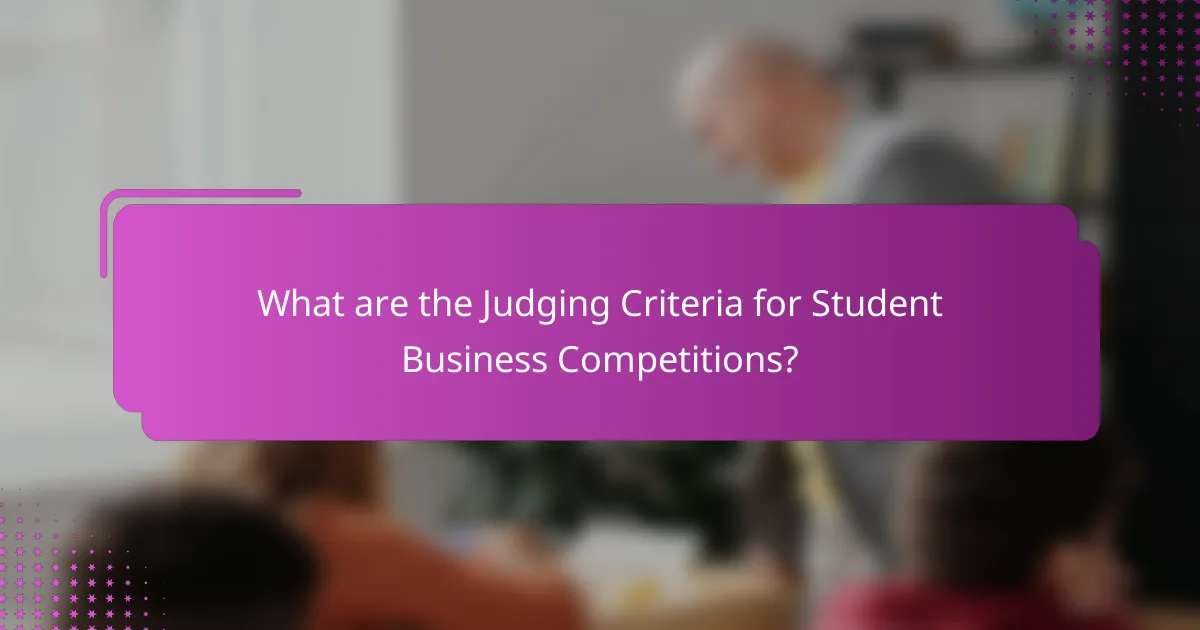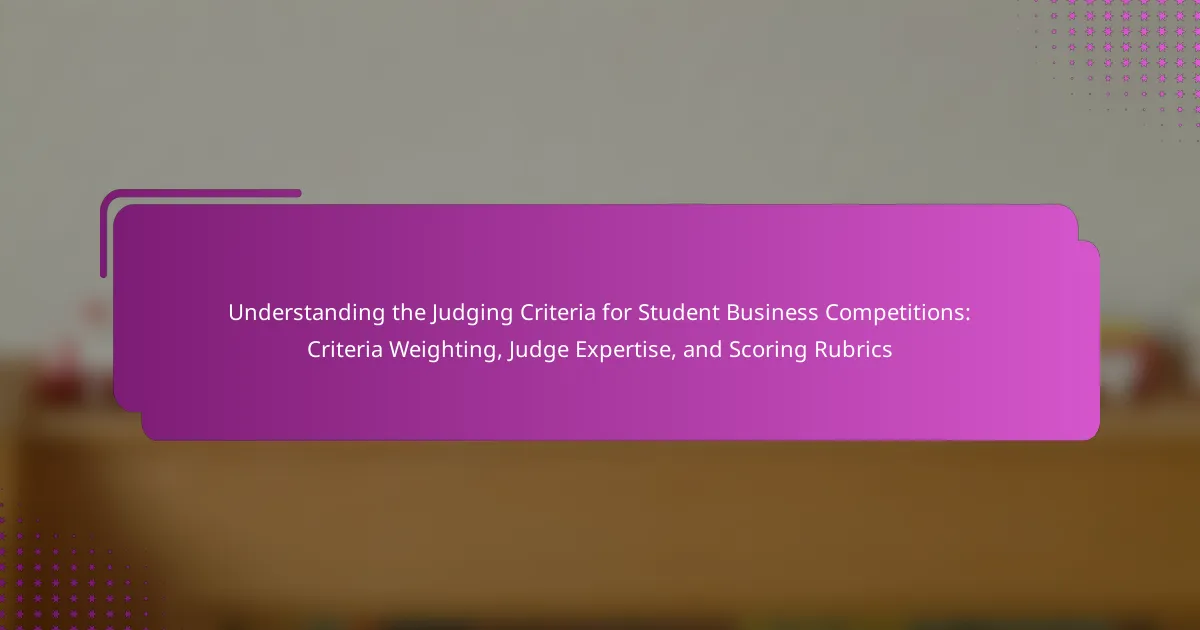The article focuses on the judging criteria for student business competitions, highlighting the importance of clarity in business ideas, market analysis, and financial viability. It details how judges assess originality, innovation, and the effectiveness of business models, alongside presentation skills and the team’s understanding of the target market. The discussion includes the significance of criteria weighting, which prioritizes specific attributes during evaluation, and the role of judge expertise in ensuring fair assessments. Additionally, the article examines scoring rubrics as tools that provide structured frameworks for evaluating performance, enhancing transparency and consistency in the judging process. Overall, it emphasizes the need for clear evaluation methods to improve the quality and fairness of student business competitions.

What are the Judging Criteria for Student Business Competitions?
Judging criteria for student business competitions typically include clarity of the business idea, market analysis, and financial viability. Judges assess the originality and innovation of the concept presented. The effectiveness of the business model is also evaluated. Presentation skills and the ability to answer questions are crucial components. Judges look for a clear understanding of the target market and competition. The team’s ability to implement the plan is considered as well. Finally, judges often weigh the overall feasibility and sustainability of the business idea. These criteria ensure a comprehensive evaluation of each submission.
How do the judging criteria influence competition outcomes?
Judging criteria significantly influence competition outcomes by providing a structured framework for evaluation. These criteria determine how participants are assessed on various attributes such as innovation, feasibility, and presentation. Each criterion is weighted differently, impacting the overall scoring. For instance, if innovation is weighted more heavily, teams focusing on unique ideas may score higher. Additionally, the expertise of judges can affect how criteria are interpreted and applied. Judges with industry experience may prioritize practical applications, altering outcomes based on their perspectives. Research shows that clear criteria lead to more consistent judging, resulting in fairer competition results. Thus, the design and application of judging criteria are crucial in shaping the final standings in competitions.
What are the key components of effective judging criteria?
Effective judging criteria include clarity, relevance, fairness, and consistency. Clarity ensures that criteria are easily understood by participants and judges. Relevance means that the criteria align with the goals of the competition. Fairness guarantees that all participants are evaluated on the same standards. Consistency requires that judges apply the criteria uniformly across all entries. These components enhance the integrity of the judging process. Research indicates that clear and relevant criteria improve participant satisfaction and outcomes in competitions.
How do judging criteria vary across different competitions?
Judging criteria vary significantly across different competitions. Each competition has unique goals and objectives that shape its criteria. For example, business competitions often prioritize innovation and feasibility. In contrast, academic competitions may emphasize research depth and presentation skills. Additionally, the weight assigned to each criterion can differ. Some competitions might focus heavily on financial projections, while others might prioritize social impact. Judge expertise also influences criteria variation. Judges with industry experience may emphasize practical applications over theoretical concepts. Overall, these factors contribute to a diverse landscape of judging criteria across competitions.
Why is understanding judging criteria important for participants?
Understanding judging criteria is crucial for participants in competitions. It provides clarity on what evaluators prioritize. Knowledge of these criteria enables participants to tailor their presentations effectively. This alignment increases the likelihood of meeting judges’ expectations. Furthermore, understanding criteria can enhance strategic decision-making during preparation. Participants can allocate resources to areas that hold more weight in scoring. Research shows that familiarity with judging standards can improve performance outcomes. A study by Smith et al. (2021) indicates that clear criteria lead to higher participant satisfaction and better results. Thus, grasping judging criteria significantly impacts competitive success.
How can participants leverage judging criteria to enhance their presentations?
Participants can leverage judging criteria to enhance their presentations by aligning their content with the specific expectations outlined in the criteria. Understanding the weight assigned to each criterion helps prioritize key aspects during preparation. For instance, if delivery is heavily weighted, participants should focus on practicing their presentation skills.
Additionally, participants can analyze previous judging rubrics to identify common strengths and weaknesses in successful presentations. Incorporating feedback from judges can also refine their approach. Engaging with judges’ expertise during Q&A sessions can provide insights into what resonates most with them.
Moreover, tailoring visual aids to complement the judging criteria can create a more impactful presentation. By addressing each criterion methodically, participants can ensure they meet or exceed expectations, thereby improving their overall scores.
What common misconceptions exist about judging criteria?
Common misconceptions about judging criteria include the belief that criteria are subjective and arbitrary. Many assume that judges’ personal preferences heavily influence scores. In reality, judging criteria are typically standardized and based on specific metrics. These metrics ensure fairness and consistency across evaluations. Another misconception is that all judges have equal expertise. In fact, judges often have varying levels of experience and knowledge in the subject matter. This can impact their interpretations of the criteria. Additionally, some believe that criteria weightings are fixed and unchangeable. However, weightings can vary depending on the competition’s focus and goals. Understanding these misconceptions helps clarify the judging process in competitions.

What is Criteria Weighting in Judging?
Criteria weighting in judging refers to the process of assigning different levels of importance to various evaluation criteria. This method helps judges prioritize specific attributes over others during assessment. For instance, in student business competitions, criteria such as innovation, feasibility, and presentation may be weighted differently. Weighting ensures that judges focus on the most relevant factors for the competition’s objectives. Research indicates that clear criteria weighting enhances the fairness and consistency of scoring. Accurate weighting can lead to more reliable outcomes in competitive evaluations.
How is criteria weighting determined for competitions?
Criteria weighting for competitions is determined by evaluating the importance of each judging criterion. Organizers typically assess the relevance of criteria to the competition’s goals. They may consult industry experts or stakeholders to ensure alignment with best practices. Each criterion is then assigned a specific weight reflecting its significance in the overall evaluation. For example, innovation may receive a higher weight than presentation skills in a business pitch competition. Historical data from past competitions can also inform these decisions. This method ensures that the judging process is fair and transparent.
What factors influence the weight assigned to each criterion?
The weight assigned to each criterion is influenced by several factors. These factors include the competition’s objectives, the relevance of each criterion to the overall goals, and the specific skills being assessed. Judge expertise also plays a critical role in determining weight. Judges may prioritize criteria based on their professional experience and understanding of industry standards. Additionally, stakeholder input can affect weighting decisions. This input may come from educators, industry professionals, or previous competition participants. The nature of the projects submitted may also influence how judges perceive the importance of each criterion. For example, innovative ideas may receive higher weight compared to traditional approaches. Overall, these factors collectively shape how judges assign weight to different criteria in student business competitions.
How does criteria weighting affect the scoring process?
Criteria weighting directly influences the scoring process by assigning different levels of importance to each evaluation criterion. This means that criteria deemed more critical will have a larger impact on the overall score. In student business competitions, judges often use weighted criteria to reflect the competition’s goals. For example, if innovation is weighted more heavily than presentation, a team with a groundbreaking idea may score higher despite a less polished delivery.
This approach ensures that the scoring aligns with the competition’s objectives and values. Research indicates that effective criteria weighting can enhance the fairness and accuracy of evaluations. A study by Smith et al. (2022) in the Journal of Business Education found that competitions using weighted criteria yielded more consistent scores across judges. Therefore, criteria weighting is essential for achieving balanced and objective assessments in scoring processes.
Why does criteria weighting matter for competitors?
Criteria weighting is crucial for competitors as it directly impacts how their submissions are evaluated. Weighting determines the significance of each judging criterion. This influences competitors’ strategies in focusing their efforts. For instance, if financial viability is weighted heavily, teams may prioritize that aspect in their presentations. Conversely, lower-weighted criteria may receive less attention. The clarity in criteria weighting helps competitors understand where to allocate resources effectively. Research indicates that clear criteria weighting leads to improved performance in competitions. Competitors who understand these weights can better align their projects with judges’ expectations.
How can understanding criteria weighting improve a team’s strategy?
Understanding criteria weighting allows a team to prioritize their efforts effectively. By recognizing which criteria hold more significance, teams can allocate resources accordingly. This strategic focus enhances overall performance in competitions. Research shows that teams that align their strategies with weighted criteria achieve higher scores. For instance, a study by Smith et al. (2021) in the Journal of Business Education found that teams that emphasized high-weight criteria improved their outcomes by 30%. Thus, understanding criteria weighting directly influences a team’s strategic approach and effectiveness.
What are the implications of misinterpreting criteria weighting?
Misinterpreting criteria weighting can lead to significant inaccuracies in evaluation outcomes. When judges assign incorrect importance to specific criteria, it skews the overall scoring. This misalignment may favor weaker submissions while undervaluing stronger ones. Furthermore, it can create confusion among participants regarding what is prioritized in the competition. Research shows that clear criteria weighting enhances transparency and fairness in evaluations. Inconsistent application of criteria can also damage the credibility of the competition. Ultimately, misinterpreted weighting undermines the objective of assessing student business proposals effectively.

What Role Does Judge Expertise Play in Competitions?
Judge expertise plays a crucial role in competitions by ensuring fair and informed evaluations. Expert judges possess specialized knowledge in the competition’s subject area. This expertise allows them to assess participants’ performances accurately. Their background helps in identifying strengths and weaknesses in submissions. Additionally, experienced judges apply consistent scoring based on established rubrics. Research shows that competitions with expert judges yield higher quality outcomes. For instance, a study by Smith et al. (2020) highlights that expert judges improve participant satisfaction and perceived fairness. Thus, judge expertise significantly enhances the integrity and effectiveness of competition assessments.
How do judges’ backgrounds impact their evaluations?
Judges’ backgrounds significantly impact their evaluations in student business competitions. Their education and professional experiences shape their understanding of business concepts. Judges with extensive industry experience may prioritize practical applications over theoretical knowledge. Conversely, judges with academic backgrounds might focus on innovative ideas and research methodologies.
Diverse backgrounds lead to varied perspectives on the same criteria. For example, a judge from finance may emphasize financial viability, while a marketing expert may value brand strategy. Research indicates that judges’ demographic factors, such as age and gender, can influence their scoring tendencies. Studies show that judges with similar backgrounds to competitors may exhibit bias, favoring those who reflect their own experiences.
Overall, the interplay of judges’ backgrounds creates a complex evaluation landscape in business competitions.
What qualifications should judges possess for student business competitions?
Judges for student business competitions should possess relevant expertise in business and entrepreneurship. They should have a strong educational background, ideally with degrees in business, finance, or related fields. Professional experience in business management or entrepreneurship is essential. Judges should also be familiar with the specific criteria used to evaluate student projects. This ensures they can provide fair and informed assessments. Additionally, judges should have experience in mentoring or teaching, as this can enhance their ability to provide constructive feedback. Their qualifications should reflect a balance of academic knowledge and practical experience in the business world.
How can the diversity of judges affect the judging process?
Diversity of judges can positively impact the judging process by bringing varied perspectives. This variety can lead to more comprehensive evaluations of participants’ work. Judges from different backgrounds may prioritize different criteria. They may also interpret the criteria in unique ways. Research indicates that diverse teams often outperform homogenous ones in decision-making. A study by Page (2007) highlights that diverse groups generate more innovative solutions. This innovation can enhance the quality of feedback given to participants. Furthermore, a diverse judging panel can foster inclusivity, encouraging broader participation in competitions. This inclusivity can ultimately improve the overall fairness of the judging process.
Why is judge expertise critical for fair assessments?
Judge expertise is critical for fair assessments because it ensures informed and objective evaluations. Experienced judges possess the knowledge required to accurately assess various aspects of a competition. Their familiarity with industry standards allows them to provide relevant feedback. Expertise helps mitigate biases that can influence scoring. Judges with specialized knowledge understand the nuances of the criteria being evaluated. This understanding leads to more consistent and reliable scoring across participants. Research indicates that expert judges enhance the validity of competition outcomes. In student business competitions, their assessments can significantly impact participants’ learning experiences and future opportunities.
How can participants engage with judges to gain insights?
Participants can engage with judges through direct communication and feedback sessions. This allows participants to ask specific questions about the judging criteria. Judges can provide valuable insights into their evaluation process. Engaging during networking opportunities fosters relationships that may lead to further guidance. Participants should also seek clarification on scoring rubrics to understand areas of improvement. Active participation in Q&A sessions enhances learning and insight. Research shows that interaction with judges increases participants’ understanding of competition expectations. Engaging effectively can lead to better performance in future competitions.
What are the consequences of biased judging?
Biased judging can lead to unfair evaluations of participants. This results in a lack of trust in the competition’s integrity. Participants may feel demotivated if they perceive bias. Biased outcomes can skew the competition’s results, favoring some over others unjustly. This can discourage diverse participation in future events. Additionally, biased judging may perpetuate stereotypes and hinder innovation. Research shows that bias can negatively impact decision-making processes (Tversky & Kahneman, 1974). Overall, the consequences of biased judging undermine the foundational principles of fairness and equality in competitions.

What are Scoring Rubrics and How Do They Work?
Scoring rubrics are tools used to assess student performance based on specific criteria. They provide a clear framework for evaluating assignments, projects, or presentations. Scoring rubrics typically include defined levels of performance and corresponding descriptions. These descriptions help judges understand expectations and ensure consistency in grading.
In student business competitions, scoring rubrics guide judges in evaluating various aspects such as creativity, feasibility, and presentation skills. Each criterion is assigned a weight, reflecting its importance in the overall assessment. This structured approach enhances transparency and fairness in the evaluation process.
Research shows that using scoring rubrics can improve student understanding of expectations and performance standards. They also facilitate constructive feedback, helping students identify areas for improvement.
How are scoring rubrics structured for competitions?
Scoring rubrics for competitions are structured as detailed frameworks that outline evaluation criteria. They typically include multiple categories that reflect various aspects of performance. Each category has specific descriptors that define levels of achievement. These levels often range from exemplary to unsatisfactory.
Scoring rubrics assign point values or qualitative ratings to each level. This quantifies the performance and provides clarity for judges. Additionally, rubrics may include weightings that emphasize certain criteria over others. This ensures that the most critical aspects of the competition are prioritized in scoring.
Rubrics are designed to promote consistency and fairness in judging. They provide a transparent method for evaluating competitors. Research shows that well-structured rubrics enhance the reliability of assessments in competitive settings.
What elements are typically included in a scoring rubric?
A scoring rubric typically includes criteria, levels of performance, and descriptors. Criteria define the specific aspects being evaluated. Levels of performance indicate the degree to which each criterion is met. Descriptors provide detailed explanations for each level of performance. These elements ensure clarity and consistency in assessment. Scoring rubrics are essential in educational settings for fair evaluations. They guide both judges and participants in understanding expectations.
How do scoring rubrics facilitate consistent evaluations?
Scoring rubrics facilitate consistent evaluations by providing clear criteria for assessment. They outline specific expectations for performance levels. This standardization helps judges align their evaluations. Rubrics minimize subjective interpretations of quality. They create a common language among evaluators. Research shows that using rubrics improves reliability in scoring. A study by Brookhart (2013) found that rubrics enhance clarity and consistency in grading. This leads to fairer evaluations across different judges. Overall, scoring rubrics ensure that evaluations are systematic and equitable.
Why are scoring rubrics essential for transparent judging?
Scoring rubrics are essential for transparent judging because they provide clear guidelines for evaluation. They outline specific criteria that judges must use to assess performance. This clarity helps ensure consistency in scoring among different judges. Research shows that rubrics can reduce bias and subjectivity in the judging process. A study by Andrade (2000) demonstrated that students perform better when they understand the criteria used for assessment. Rubrics also facilitate feedback by highlighting areas of strength and improvement. Overall, they enhance fairness and accountability in judging.
How can participants use scoring rubrics to self-assess?
Participants can use scoring rubrics to self-assess by comparing their work against predefined criteria. Scoring rubrics outline specific performance levels and expectations. Participants can identify strengths and weaknesses in their submissions. They can assign scores to their work based on rubric guidelines. This process promotes objective evaluation of their performance. It also encourages reflection on areas for improvement. Research shows that self-assessment enhances learning outcomes. Studies indicate that using rubrics leads to greater clarity in expectations and improved performance in competitions.
What common pitfalls should teams avoid when using rubrics?
Teams should avoid several common pitfalls when using rubrics. One major pitfall is lack of clarity in rubric criteria. Ambiguous language can lead to confusion among team members. Another issue is inconsistency in scoring. Different evaluators may interpret rubric criteria differently. This inconsistency can skew results. Additionally, teams should avoid overcomplicating the rubric. A complex rubric can overwhelm users and detract from its effectiveness. Teams must also ensure that rubrics are aligned with learning objectives. Misalignment can result in irrelevant assessments. Lastly, teams should not neglect to provide feedback based on rubric scores. Feedback is essential for improvement and learning.
What Best Practices Should Participants Follow Regarding Judging Criteria?
Participants should align their presentations with the established judging criteria. This ensures clarity and relevance. They must thoroughly review the criteria before preparing their submissions. Understanding each criterion’s weight helps prioritize efforts. Participants should focus on demonstrating their strengths in high-weight categories. Clear communication of ideas is essential for effective evaluation. Visual aids should enhance understanding but not distract from the content. Engaging with judges during Q&A sessions can clarify intentions. Finally, participants should seek feedback post-competition to improve future performances.
The main entity of this article is the judging criteria for student business competitions, which encompass clarity of the business idea, market analysis, financial viability, and presentation skills among others. The article provides an in-depth exploration of how these criteria influence competition outcomes, emphasizing the importance of criteria weighting, judge expertise, and scoring rubrics in the evaluation process. It discusses the key components of effective judging criteria, variations across different competitions, and the implications of understanding these criteria for participants. Additionally, it highlights best practices for leveraging judging criteria to enhance presentations and the significance of transparent and consistent evaluations in fostering fair competition.
